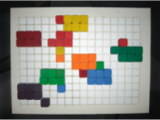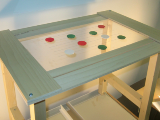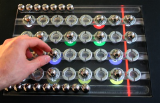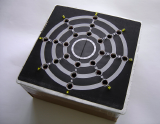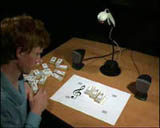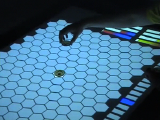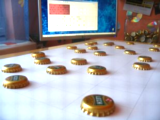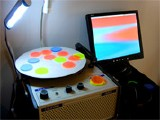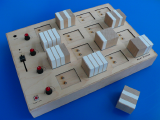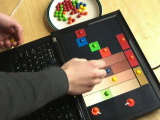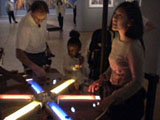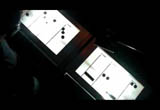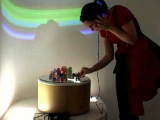Token based Sequencers
-
BeatBearing
year: 2008
author(s): Peter Bennett,
Sile O'Modhrain
affiliation: Sonic Arts Research Centre, Queens University, Belfast
publication: The BeatBearing: a Tangible Rhythm Sequencer [PDF]
website: http://www.beatbearing.co.uk/
The BeatBearing is a novel musical instrument that allows users to manipulate rhythmic patterns through the placement of ball bearings on a grid. The BeatBearing has been developed as an explorative design case for investigating how the theory of embodied interaction can inform the design of new digital musical instruments. Although simple, this allows for an engaging and intuitive musical experience. The BeatBearing is an ongoing sketch aiding the design of new tangible interfaces for musical instruments.
-
Rhythm Ring
year: 2008
author(s): Brian Yung,
Hanson Jiang
affiliation: Cornell University
website: https://people.ece.cornell.edu/land/courses/ece4760/FinalProjects/s2008/bmy5_hcj4/bmy5_hcj4/
The Rhythm Ring interactive rhythm sequencer is an engaging musical device that enables the user to create a plethora of rhythms and beat patterns with the touch of their own fingers. The Rhythm Ring provides a tangible method of arranging a musical rhythm. In our design, the user can arrange beats and modify them in real time by moving steel ball bearings between holes - a physical representation of notes on a musical staff. The Rhythm Ring continuously loops up to three tracks, each with its own voice. A central ring of LEDs provide the user with live feedback for current "playhead" position, and bright LEDs pulse when a note is played due to a detected bearing. The three tracks allow the playback of three different percussion sounds: snare, hi-hat, and bass drum.
-
audio d-touch
year: 2003
author(s): Enrico Costanza,
Simon Shelley
affiliation: MIT Media Lab, Electronic Publishing, University of York
publication: Tangible User Interface for Music Composition and Performance [PDF]
website: http://www.d-touch.org/audio/
Audio d-touch is a set of 3 applications for music composition and performance: the Augmented Stave, the Tangible Drum Machine and the Physical Sequencer. It uses a consumer-grade web camera and customizable block objects to provide an interactive tangible interface for a variety of time based musical tasks such as sequencing, drum editing and collaborative composition. d-touch is a framework for the development of tangible user interfaces based on computer vision.
-
reactogon
year: 2007
author(s): Mark Burton
affiliation: Multimedia Design, Northumbria University
The Reactogon - a concept study and not an actual implementation - is a "chain reactive performance arpeggiator", which dynamically creates arpeggio sequences based on marked tokens placed on an interactive surface. Each hexagonal cell represents a fixed note on the harmonic table. The placement of the discs influences whether or not a note is played, as well as its placement in the sequence. By stringing together a number of directional discs, an entire musical sequence can be created. Special discs can also initiate multiple sequences, for more complex patterns. A bank of touch-sensitive sliders are then used to change volume, timbre and rhythm of the notes.
-
BeatMachine
year: 2008
author(s): Marcin Wałęsa,
Krzysztof Wojtas,
Jan Mazurczak
website: http://mw.boo.pl/beatmachine/
BeatMachine is musical sequencer, where you can easily create music using plain beer capsules. The capsules are placed on a translucent table surface which is structured with a simple grid. A webcam from underneath tracks the shadows of the caps, which trigger different sounds according to their position.
-
Bubblegum Sequencer
year: 2008
author(s): Hannes Hesse,
Andrew McDiarmid
affiliation: School of Information, UC Berkeley
publication: The Bubblegum Sequencer [PDF]
website: http://www.backin.de/gumball/
The Bubblegum Sequencer is a physical step sequencer that lets you create drumloops by arranging colored balls on a tangible surface. It generates MIDI events and can be used as an input device to control audio hardware and software. Finally, people can't claim anymore that electronic music isn't handmade. A grid of holes, consisting of several rows with 16 holes each is the canvas, where colored gumballs can be arrange. The 16 columns represent the 16th-notes in a measure, each color is mapped to a specific sample.
-
spinCycle
year: 2006
author(s): Spencer Kiser
affiliation: New York University, Interactive Telecommunications Program
publication: spinCycle: A Color Tracking Turntable Sequencer [PDF]
website: http://www.spencerkiser.com/spincycle/
spinCycle is a turntable that allows you to arrange and play colors visually and musically. It is fitted with a camera that takes the place of tonearm on a normal turntable. Rather than a needle playing grooves in a record, spinCycle creates sounds based on colors that the camera sees. The DJ places brightly colored plexiglass circles on the spinning platter, creating beautiful color patterns that are then translated into sounds. The DJ can rearrange the discs at any time, thereby creating a new soundtrack on the fly. SpinCycle also captures the colors the camera sees and can either project them on a wall or display them on a computer monitor. This hypnotic display changes as the music changes, providing a fun synchronized multimedia experience.
-
Beat Blocks
year: 2006
author(s): Jeff Hoefslinked,
Stijn Schiffeleers
website: http://www.beatblocks.com
Beat Blocks is a tangible interface for a rhythm sequencer. The user is able to create and manipulate a 4-track drum loop by physically re-arranging wooden blocks within a 4x4 grid. What this enables is anyone with little or even no musical background to create and take command of a rhythmic composition. No time is needed to read a manual or learn a complicated interface. The basic act of re-arranging objects is all that is required to get started and the result is familiar enough to be instantly rewarding.
-
I eat beats
year: 2008
author(s): Kyle McDonald
website: http://kylemcdonald.net/
Skittle-based beat sequencer, a tangible and edible music interface. This is a prototype inspired by the beat bearing sequencer, but uninfluenced by the bubblegum sequencer, developed with a webcam and Processing. A web cam is mounted above the screen, and Skittles are placed on the laptop screen. Version 2 implements a generic control surface with the aide of a linear polarizer to cancel out the screen.
-
cool - circular optical object locator
year: 2002
author(s): Tim Hankins, David Merrill, Jocelyn Robert
affiliation: CCRMA,
Stanford University
publication: Circular Optical Object Locator [PDF]
website: http://ccrma.stanford.edu/~dmerrill/250a
The Circular Optical Object Locator is a collaborative and cooperative music-making device. It uses an inexpensive digital video camera to observe a rotating platter. Opaque objects placed on the platter are detected by the camera during rotation. The locations of the objects passing under the camera are used to generate music.
-
scanjam
year: 2003
author(s): Murat Konar,
Adrian Ashley,
Mikkel Köser
affiliation: Royal College of Art,
Interaction Design
website: http://www.muratnkonar.com/id/scanjam
Scanjam - a concept study and not an actual implementation - is a music performance system consisting of two scanners and a computer. It takes advantage of the time-based nature of the scan head and maps each scanner to one bar of music. The music is composed in two bar "modules". Objects placed on the scanner are read and depending on their color, shape, and vertical placement, trigger sounds when the scan head passes them by. When one scanner reaches its end the next scanner begins. While the second scanner is scanning, the first scanner is "rewinding".
-
bach blocks
year: 2006
author(s): Shaun Moon,
Ellen Yi-Luen Do,
Mark D Gross,
Susan Finger
affiliation: Computational Design Lab, School of Architecture, Carnegie Mellon University
publication: Bach Blocks: Making Space, Making Music [PDF]
website: http://code.arc.cmu.edu/lab/html/project105.html
Bach Blocks is a game that encourages children to create totally original music. The blocks are physical analogs to musical notes with color associated to pitch and block size to beat length. As children arrange the blocks on a play tray, image processing software determines the position and color of each block. Adjacent blocks of the same color are processed as one block providing a way for children to create more varied rhythms. They can also create harmony by placing blocks perpendicular to the melody direction. Bach Blocks can play the musical output of the block arrangements in one of four directions: up, down, left or right. This flexibility creates a richer play environment where the rhythm of one melody is the harmony in another. This encourages more two-dimensional thinking about music and spatial relationships between blocks on the play tray.
-
RGB Player
year: 2004
author(s): Toke Oliver Barter
affiliation: Royal College of Art,
Interaction Design
website: http://www.tokebarter.com/rca/Projects/rgb/Rgb_player.html
The RGB player is a musical instrument wit a built in scanner. Play the instrument by placing the coloured objects onto the surface of the rotating glass disc. As an object passes over the scanner beneath the disc - its colour values are sampled generating sound in response to these colours and the object's distance from the centre. The closer to the centre an object is situated, the higher a pitch is achieved. Simple melodies can easily be achieved by creating patterns of objects on the disc - where adding or removing objects will allow the nature of the performance to change.
-
MusiCam
year: 2007
author(s): Derek Yau
affiliation: Cybernetics & Computer Science
publication: MusiCam - An Instrument to Demonstrate Chromaphonic Synesthesia [PDF]
MusiCam is a novel musical controller and ambient HCI device. Inspired by a type of Synesthesia where colour typically induces musical notes the project investigates this unusual condition, particularly the transition from colour to sound. The MusiCam system explores the potential benefits of this oddity as a mode of Human Computer Interaction (HCI), providing a host of vibrant applications. Colour data is interpreted by means of an off the shelf webcam, and music is generated in real-time through regular speakers. This simple design flexibility allows for any personal computer to take on the identity of an interactive musical device.
-
tangible notes
year: 2006
author(s): Tsung-Hsien Wang,
Ellen Yi-Luen Do,
Mark D Gross
affiliation: Computational Design Lab, School of Architecture, Carnegie Mellon University
publication: angible Notes: Making Music Palpable [PDF]
website: http://code.arc.cmu.edu/lab/html/project107.html
Tangible Notes is an interactive music toy designed for preschool children to explore musical scales and notes. As children place or move the musical notes around the playing board, Tangible Notes plays the resulting tune. It encourages children to learn rhythm and melody through physical movement. Tangible Notes transfers notes placed on a staff into an interactive perfomance. By direct and haptic manipulation, children can learn positions of notes, hear them and create their own melodies from sequences of music notes.
